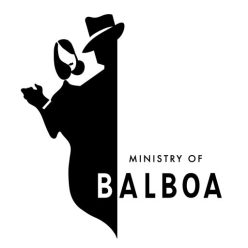What is Balboa
Balboa is a stylish, energetic, up-tempo swing dance, danced in an up-right position. It originates from the 1920s and 1930s Southern California and is said to have got its name from the Balboa peninsula, near Newport and Long Beach where it was invented. Balboa – like other cool dances of the swing era, e.g. Lindy Hop – was danced everywhere till around the Second World War and then was close to die out, only danced by a small Californian community. Now in the new Millennium, Balboa, like Lindy Hop in the 1990s, has got a revival and is today danced all over the world.
Back in the swing era, young people gathered in huge numbers to dance in the overcrowded dance halls along the beach.

Nice interior of the Rendezvous from the late 1930’s. Source: www.caljazzdance.com
Balboa, unlike other swing dances, is often danced in closed position (close to the dance partner) and there is an anecdote that balboa evolved because young people gathered by the 1000s in dance halls. Balboa was originally a response to the overcrowded ballrooms where the break away (a move popular in lindy hop at the time) was often difficult, if not banned by the venue. Balboa is often perceived as a restrained or introverted dance where you at all times are in close connection with your partner, with most movement below the knees.
As hinted by the title, what today we call Balboa actually consists of two dances: Balboa (some times referred to as ‘Pure Bal’ or ‘Pure Balboa’) and Bal-swing (or simply Swing) that is constantly mixed on the dance floor. Balboa-swing is sometimes used as a collective term for both but when we talk about it, usually we simply just call it ‘Balboa’. Common for both dances are that they are both danced with a partner to eight-count swing music. Confused? Read on…
-
- Balboa: Today sometimes referred to as “Pure Bal”. Balboa is a form of swing dance that started as early as 1915 and gained in popularity in the Swing Era, especially during the 1930s. Like Lindy Hop and Jitterbug it originates from the mother of all Swing dances: Charleston. Others have stated that it originated from Foxtrot. Dancers stay in close embrace at all times, their upper bodies touching, doing variations based on footwork, turning as a couple, and moving as a couple. The art of Balboa is the subtle communication between the lead and follow: like weight shifts that most spectators cannot see. As a result, Balboa is considered more of a “dancer’s dance” than a “spectator’s dance” or as said by a Balboa dancer: “As soon as you start attracting attention to yourself, you [are] not doing Balboa anymore”. Since the footwork is so small, Balboa can be danced to very fast music (over 300 beats per minute) – although it can, indeed, be danced to all tempos of music – and you’ll often see swing dancers who otherwise prefer, e.g., Lindy Hop, switch to Balboa when the tempo gets too fast. Balboa is also danced to slow music (under 100 beats per minute), which allows more time for intricate footwork and variations.
A video showing pure balboa:
-
- Bal-swing: Originally known as just “Swing” or sometimes “Randy Swing” in Newspaper articles of that time is an eccentric dance unlike Balboa. This dance style – like other swing dances – came from Charleston and its earliest known use was a contest in Venice Beach in 1932. The name “Bal-Swing” came about during the 1970s from an attempt to differentiate the dance from the much more general term “Swing Dancing.” While dancing Bal-swing, the closed connection of the Pure Bal can be broken, with partners doing different variations. Spectators will surely regard Bal-swing as being flashier.
A Video showing bal-swing combined with pure balboa:
Balboa today is commonly used as a general term for dances that come from southern California during the 1920’s and 30’s, which makes the history very confusing. Most of the original Balboa dancers have long passed and many of the swing dancers that followed continued to use the original steps and sometimes styles to integrate into their swing dancing which some people today call bal-swing.
Note: there does not exist a ‘history of Balboa’ and the above information is gathered from a diverse collection of information on the net, often contradicting each other.
